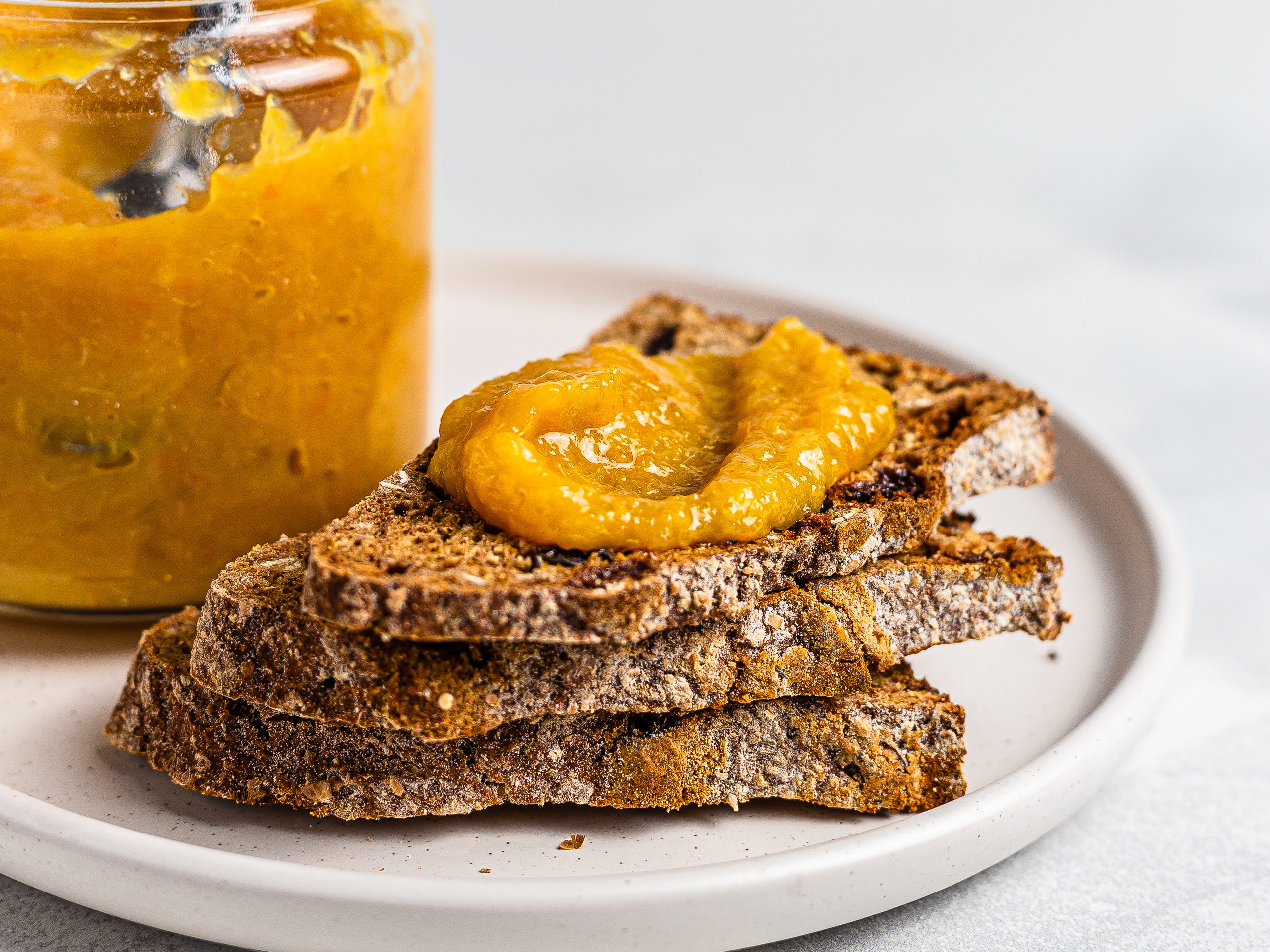Did you know that for every two spoons of classic orange jam you slurp, you are eating one full spoon of white sugar? Say no to that! Today we'll show you how to make a smooth orange marmalade completely sugar-free and without using artificial pectin.
Of all homemade jams, orange marmalade is probably the trickiest. Worry not, we have tested this recipe extensively and will share with you everything we have learned to help you get great results while having fun.
First of all, the traditional orange jam requires a certain type of orange. To get a thick jam, you need to use bitter and pectin-rich oranges, like the Seville variety. As they are not always easy to find, we adjusted our recipe to work with any orange. But we recommend you pick a sweet variety to minimise the amount of sweetener needed.
Seville oranges work great because they have a lot of seeds and white bits which are rich in pectin. In the classic marmalade recipe (the one with bits), you put these pectin-rich bits into a cheesecloth and let it cook with the rest of the ingredients. The problem is that those bits are also the most bitter parts of the orange. That's why in the classic recipe you use so much sugar: to compensate (and to preserve it).
Our recipe doesn't use the white bits of the orange, so we won't need to sweeten it a lot. Depending on the variety of oranges you picked, you may have to use no sweetener at all. In the steps below, we'll show you how to sweeten the jam using erythritol (a safe sweetener that contains zero sugars).
So how did we make the jam thick, without sugar and pectin? We used starch (potato or corn), just as we did for our other pectin-free strawberry jam. This technique works brilliantly, and it's very easy to apply. We also tested the recipe using applesauce and found it to be an excellent option as well. Check out the FAQ section below where we tell you how to use applesauce instead of starch. Remember to check the Tips section as well for more useful advice.
Overall, we are very pleased with this smooth orange marmalade. It's easier to make than the classic orange jam with bits, as it involves fewer steps. It's healthier because it contains zero refined sugars. And it's more accessible as you can prepare it with any variety of oranges.
NOTE: The default ingredients yield about 600g (1.3 lbs) of orange jam, enough to fill two 300g (10 oz) jars. We calculated that one serving is 30g (1 oz).
How to sterilise jars for canning?
Sterilise the jam jars and lids by first cleaning them with soap and rinsing thoroughly. Now dip them in a deep pan filled with cold water and turn on the heat.
Bring the water almost to the boil and keep the jars well covered for 15 minutes.
Let the lids dry on a rack and transfer the jars in the oven preheated at 160°C (320°F). Do not touch the inside of the jar and bottom of the lid with your bare hands to avoid contamination.
How to prepare oranges faster when making jam?
Making orange jam requires a bit of preparation work. Oranges have many parts; some of them you need, some you don't. Cleaning oranges takes time, but here we'll give you some tips to speed up the process.
First of all, these are the orange parts you will need to isolate when making orange jams:
skin (or rind)
pith (the white part under the orange skin)
the orange segments (the flesh)
the white bits and seeds between the segments
You always discard the pith, as it is too bitter. In the traditional recipe, you put the white bits and the seeds in a cheesecloth to thicken the jam. In our recipe, we use an alternative method, so you can also discard these parts.
Ok, now let's see how we can clean an orange faster.
How to peel the orange skin faster. Instead of peeling the orange like you would an apple, use a grater. Give a single stroke with your grater to a pristine section of skin, then rotate it and continue to the next section. Do so until you grated the whole orange. Why only one stroke? It's because you don't want to grate the white part of the rind (the one under the orange peel) as it's too bitter.
How to extract the orange flesh faster. Once you have discarded the pith, you have the core of the orange in your hands. The next goal is to get the flesh (the segments) and isolate the seeds and the white bits. Because in our recipe above we discard these last two parts, you can do the following:
Squeeze the orange
Collect the juice
Scrape the inside of the squeezed orange
Put the pulp and scraped bits into a medium sieve.
Press down the pulp with the back of a spoon and collect the orange pulp.
Discard the white bits and the seeds that are in the sieve.
When we make things fast, we lose some precision. Sometimes, it's worth it if the result is still good. If you are making a lot of orange jam and you don't want to spend an hour or more cleaning the oranges, then these tricks may just save your afternoon!
How can I make sugar-free orange jam without pectin?
If you don't want to use pectin when making jams, you need a different way to thicken the jam. As of writing, we have used four ingredients to replace pectin, in four different jam recipes.
Here are the thickeners that you can use:
Chia seeds — see our blackberry jam
Ground flaxseeds — see our blueberry jam
Starch — see our strawberry jam or the orange jam above
Apples — see our plum jam
Orange jam vs orange marmalade: what's the difference?
Technically, a jam contains only the flesh of a fruit, while a marmalade contains the flesh and the rind (the skin). You often make marmalades with citrus fruits, like orange.
You could say that marmalades are a sub-group of jams because all marmalades are jams, but not all jams are marmalade.
Some marmalades are smooth (the skin gets blended with the flesh into a smooth jelly), while others have bits.
Our orange jam above is a smooth marmalade because we used both the skin and the flesh of the oranges, and we have blended everything.
Which oranges are best?
In the traditional orange marmalade, you need to use oranges that are rich in pectin. Seville oranges are the standard choice.
These oranges have seeds and white bits that are incredibly bitter. These are the bits that contain pectin, which is responsible for making thick jelly-like jams.
Because in our orange jam we use a different way to thicken the jam, you can use whatever variety of orange you have at hand. We suggest you select a sweet variety and one without seeds.
A sweet orange will reduce the amount of sweetener you need to use in our recipe, while a seedless variety will be easier to clean.
Ingredients
| Ripe Oranges | 1.5 kg |
| Water | 220 mL |
| Erythritol | 220 g |
| Starch (Potato or Corn) | 2 tbsp |
Step 1
We recommend using a sweet and seedless variety of oranges for this jam recipe. Check out our FAQ section for more tips and information.
Rinse well half of the oranges and then grate the zest making sure you're scraping only the bright orange part of the rind. Leave behind the white layer (pith) underneath as it's very bitter (1).
Next, take all the oranges, peel off and discard the thick pith from each orange so that you'll have just the flesh of the fruit without any white bits (2).
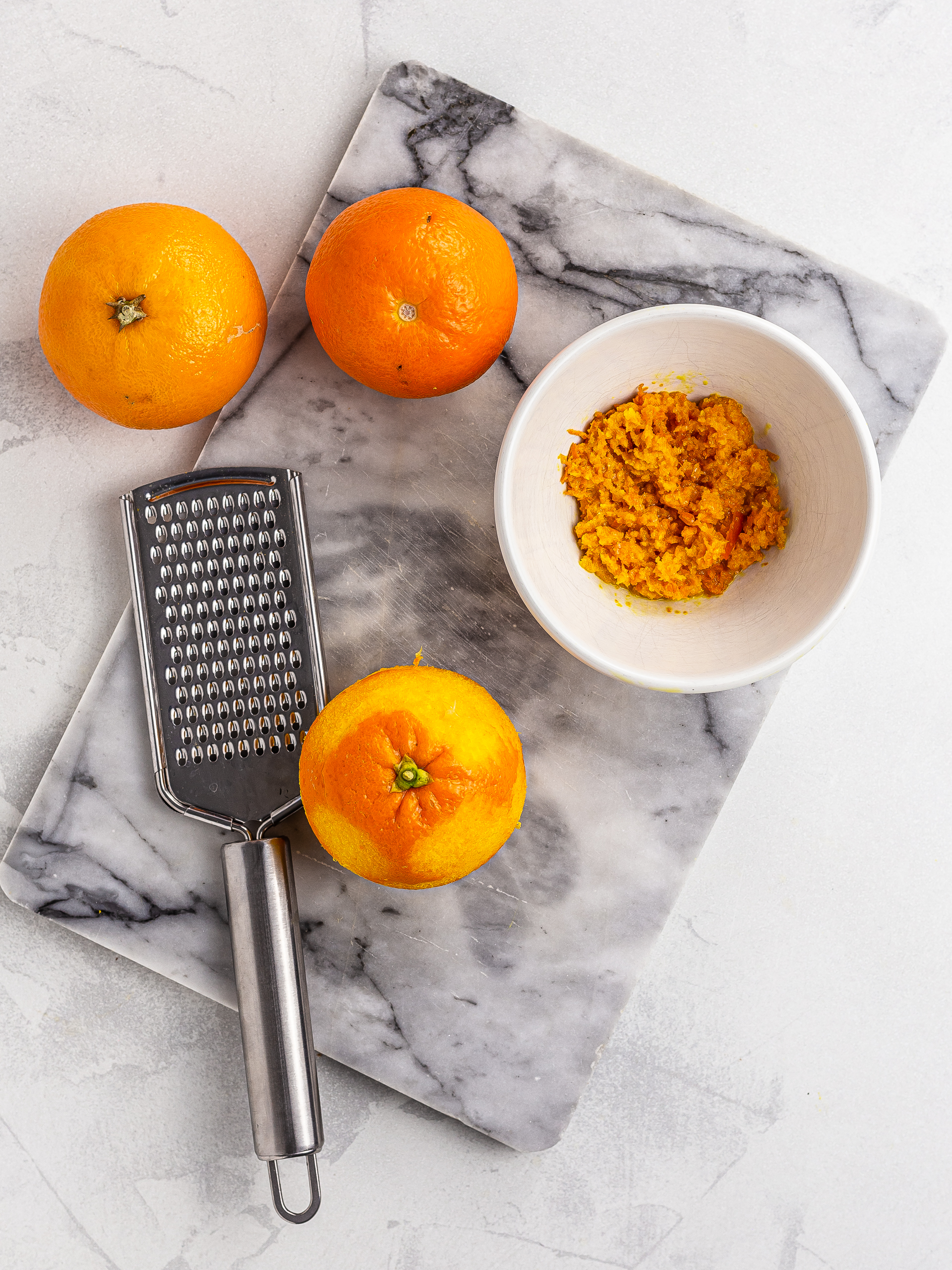
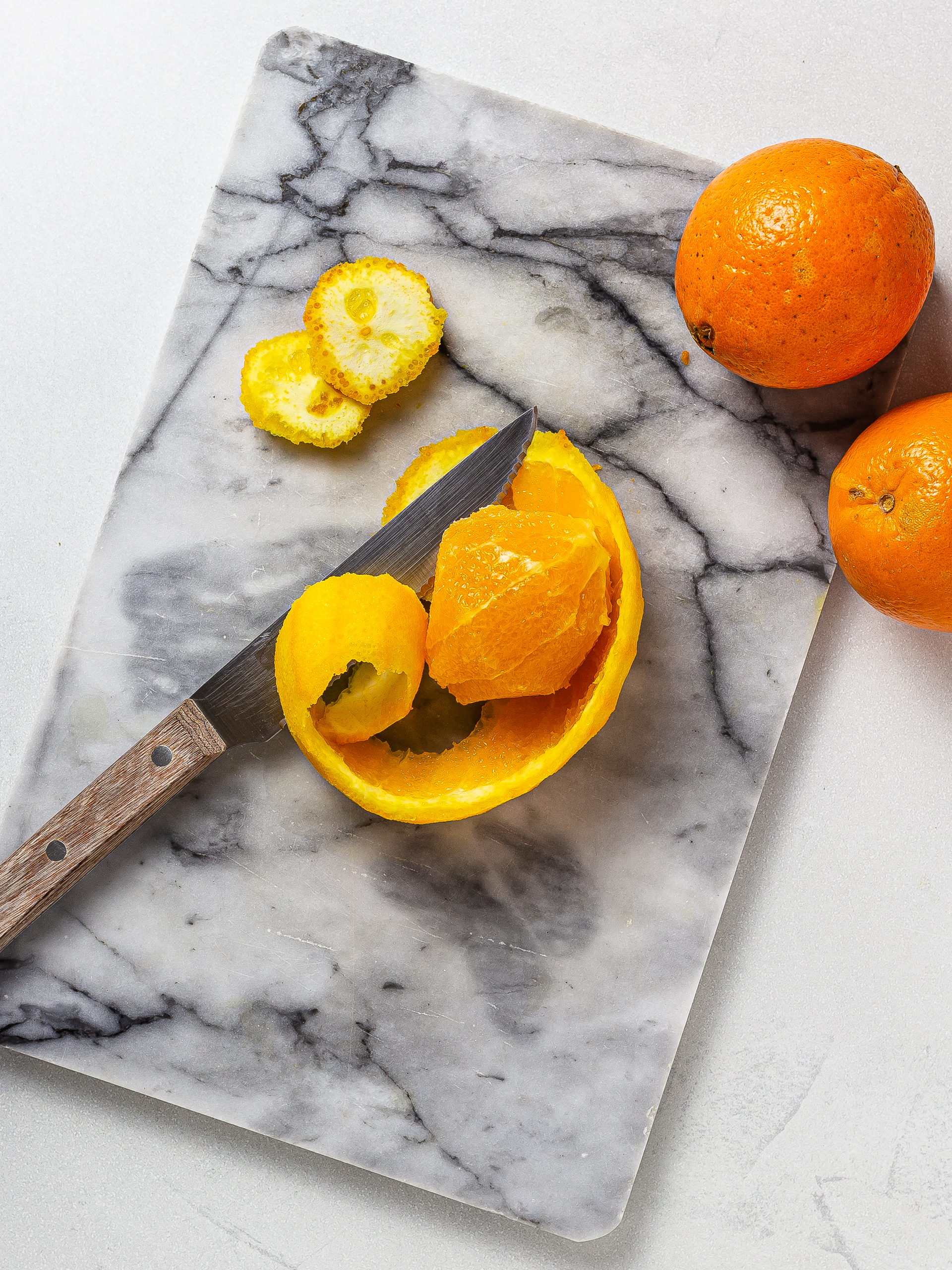
Step 2
Now, use a sharp knife to cut out orange segments, leaving behind the white membrane that is in between them (1).
By doing so, you won't have any bitter part of the orange ending up in your jam, and you'll have to use less sweetener.
Keep a bowl under the oranges as you cut them to collect any juice that might drip.
Then, squeeze what's left of the oranges to extract more juices and discard the squeezed membranes. Collect the juices, segments, and zest into a bowl (2).
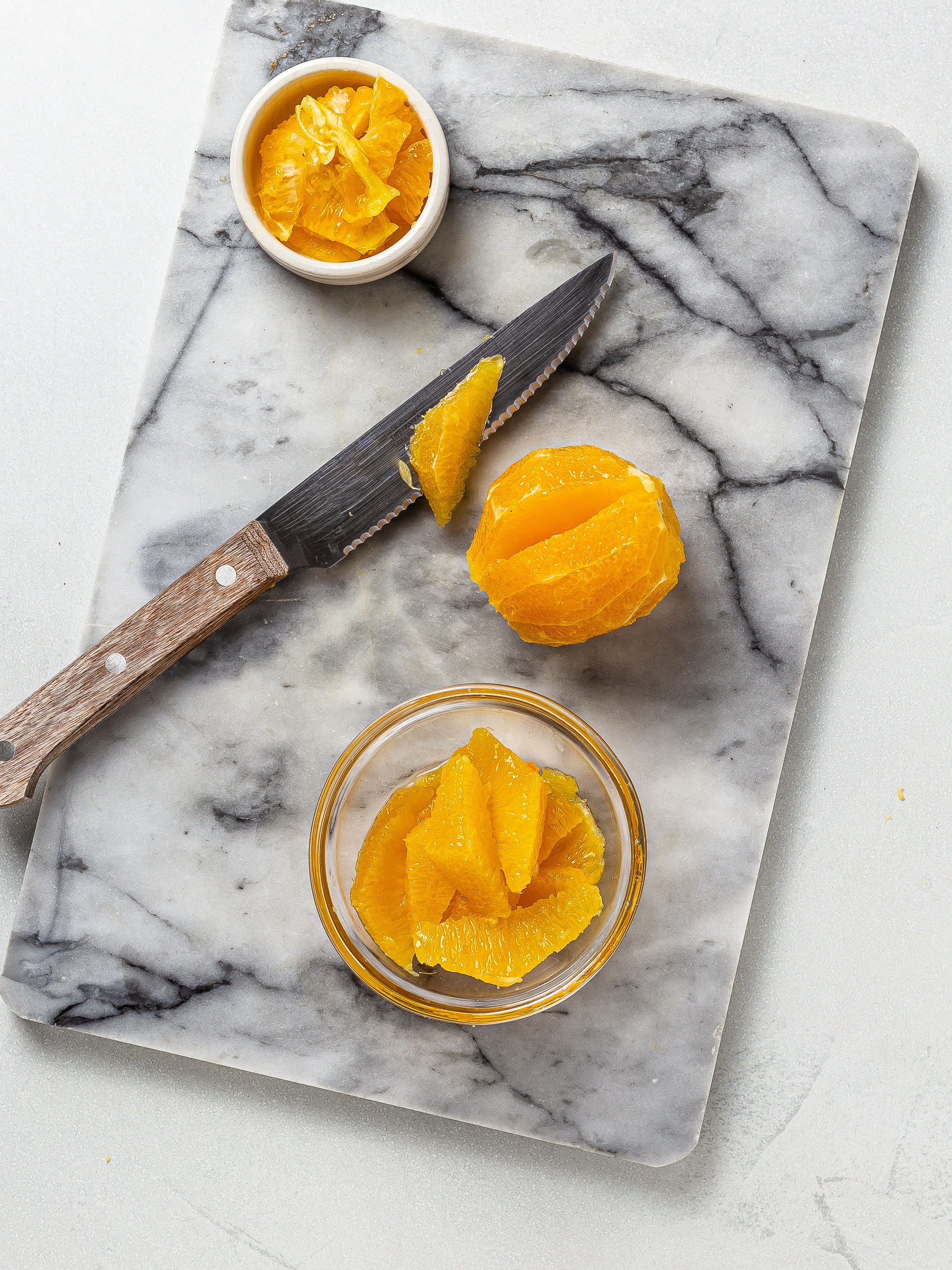
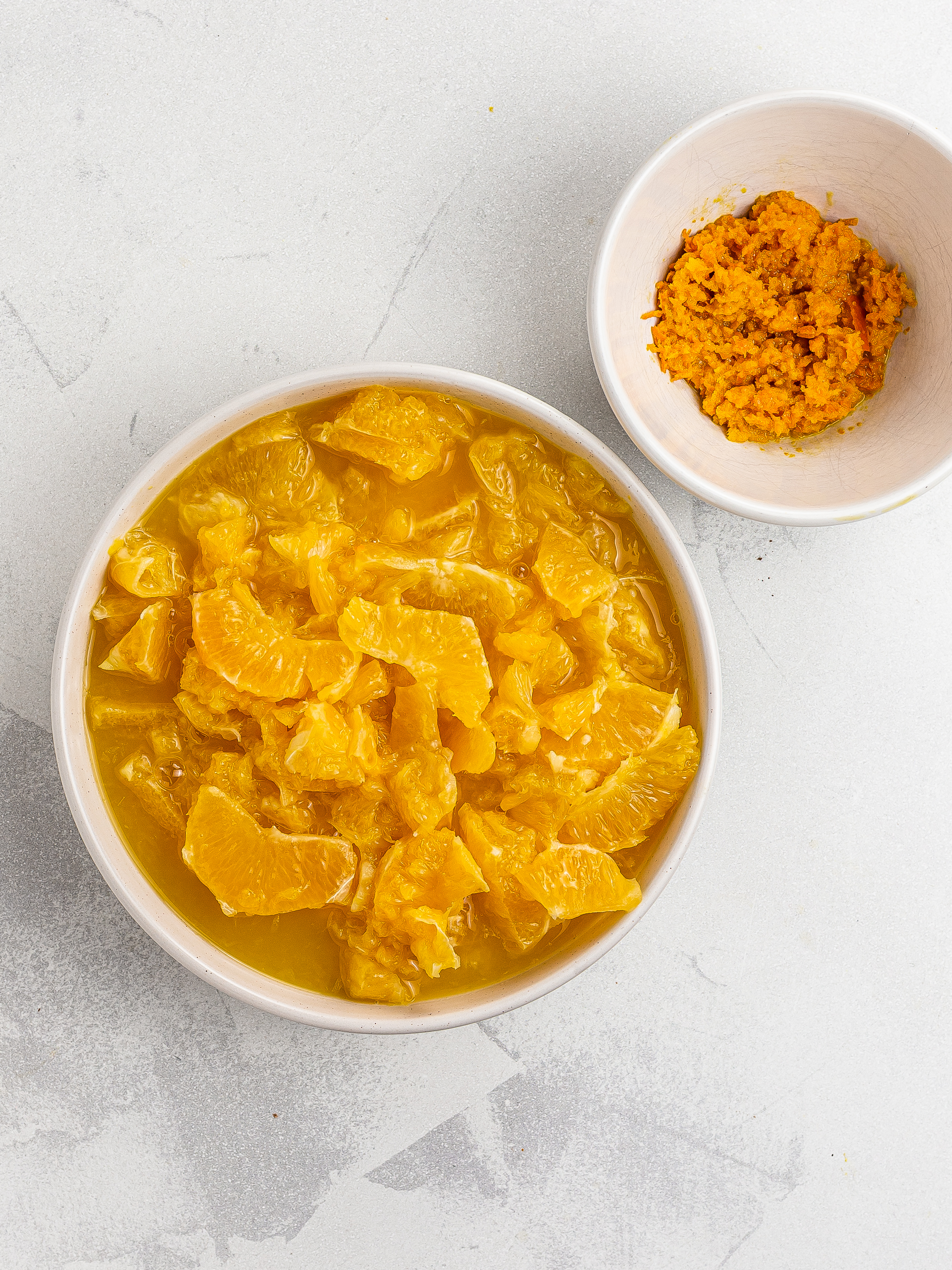
Step 3
Transfer the orange juice, segments, and zest into a pot. Pour in the water and stir in the erythritol.
Bring the mixture to a boil, stirring occasionally, and then let it simmer over low heat for 15 minutes.
At this point, we recommend tasting the jam. If you feel it's too bitter, then add more erythritol until it reaches your desired level of sweetness.
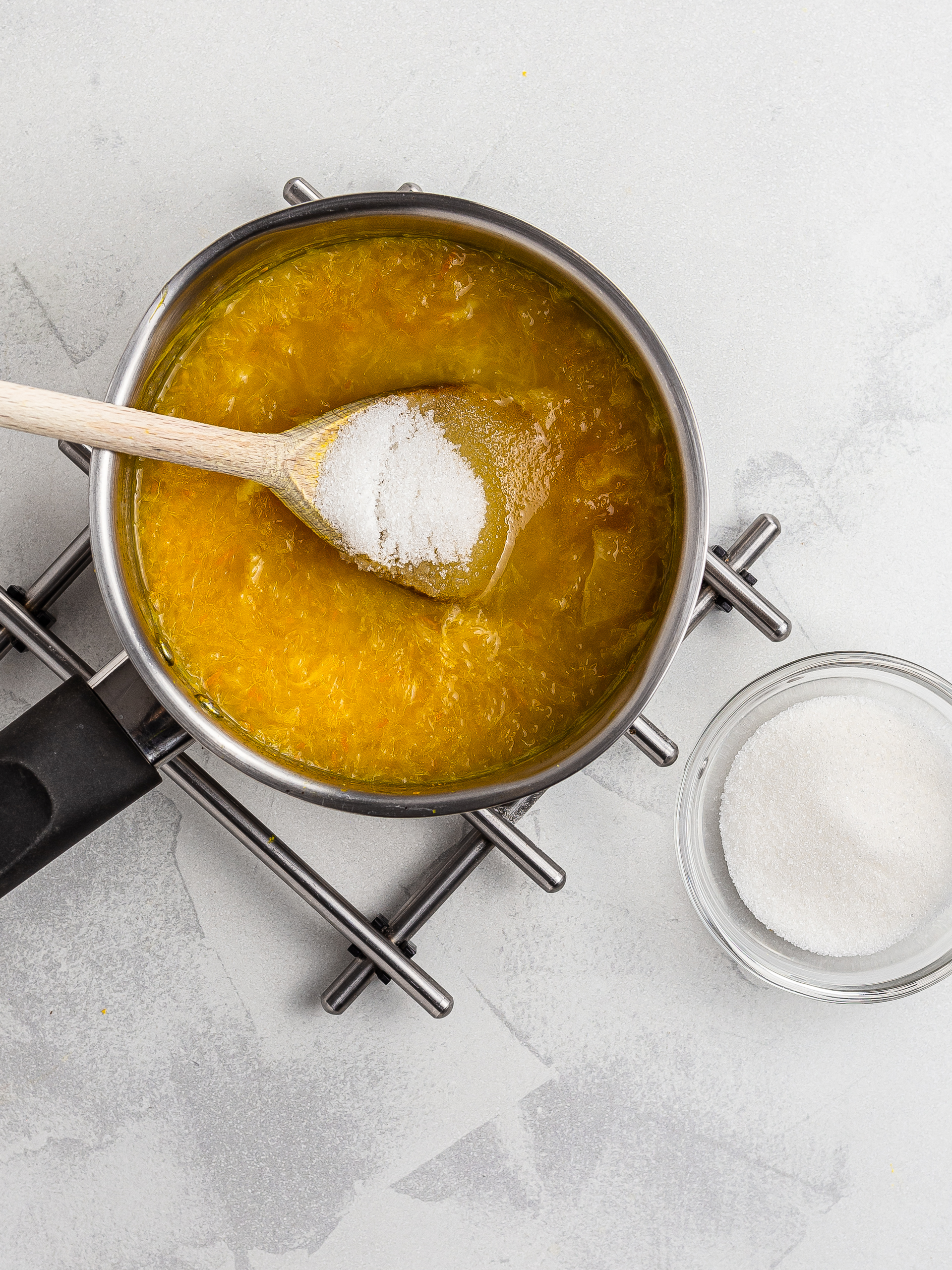
Step 4
Now, blend the mixture into a smooth jam using an immersion blender or a food processor.
Then, cook it for a further 15 minutes over low heat, always stirring to prevent the jam from sticking to the bottom and getting burnt.
Dissolve the starch in a little bit of cold water and then add it to the pot. Stir for a minute or until the jam starts to thicken. Then, remove the pot from the heat and keep stirring vigorously for one more minute.
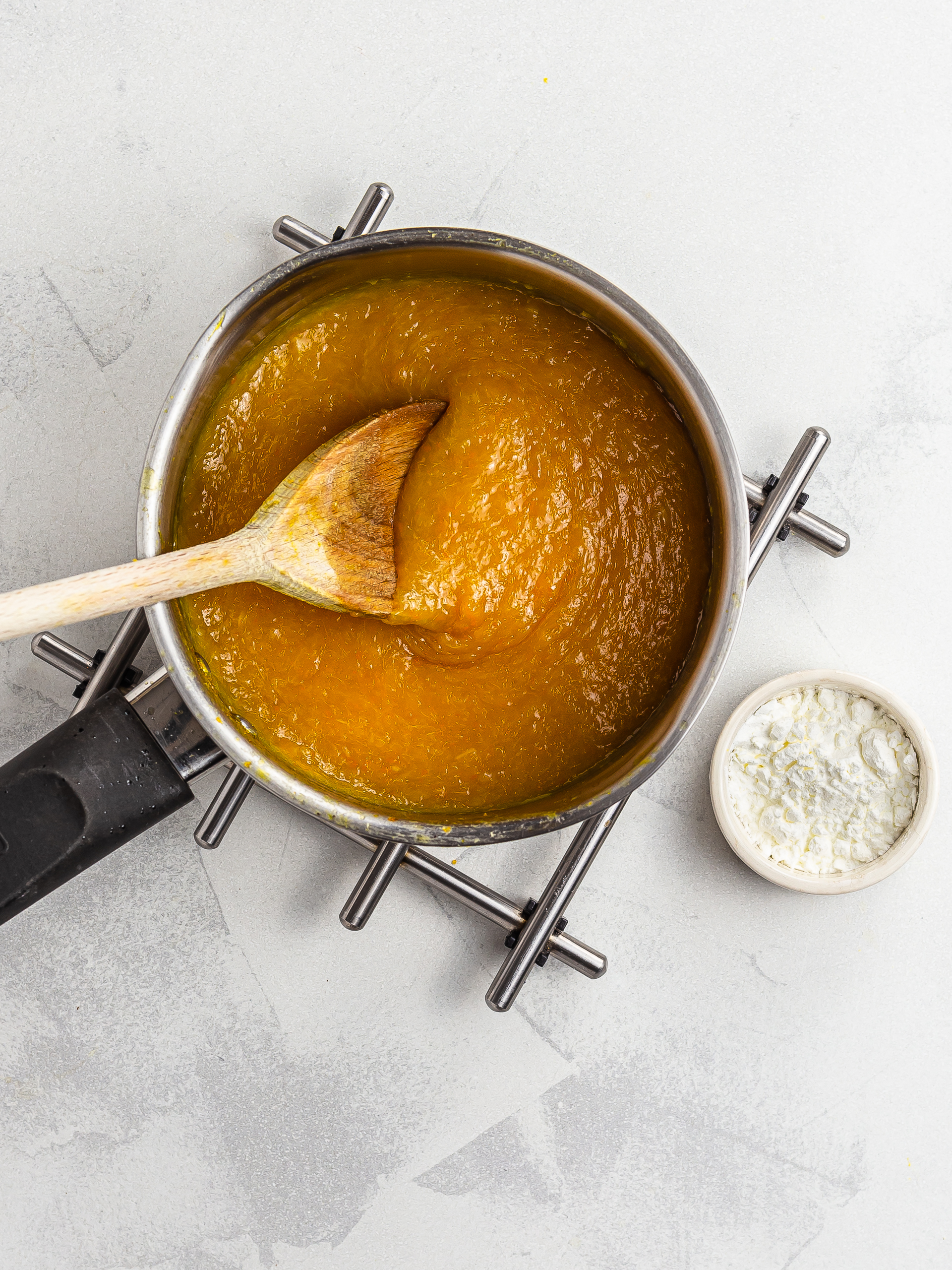
Step 5
If you want to preserve the jam, make sure your jars, lids, and ladle are sterilised. You can check out our FAQ section for tips on how to do it.
Fill the jar with jam leaving 3 cm (1 inch) headspace and using a clean non-metallic spatula, give a little stir to get rid of any air pockets. Clean the rim of any jam residue.
Now, press the lid down, flip the jar, and quickly tighten the lid to seal the jar (1).
Leave the jar upside down for 30 minutes. If after this time the lid doesn't pop when pressed in the centre, your jar is sealed, and you can flip it back up (2).
If you're planning on eating all the jam within a week, you can skip the sealing process.
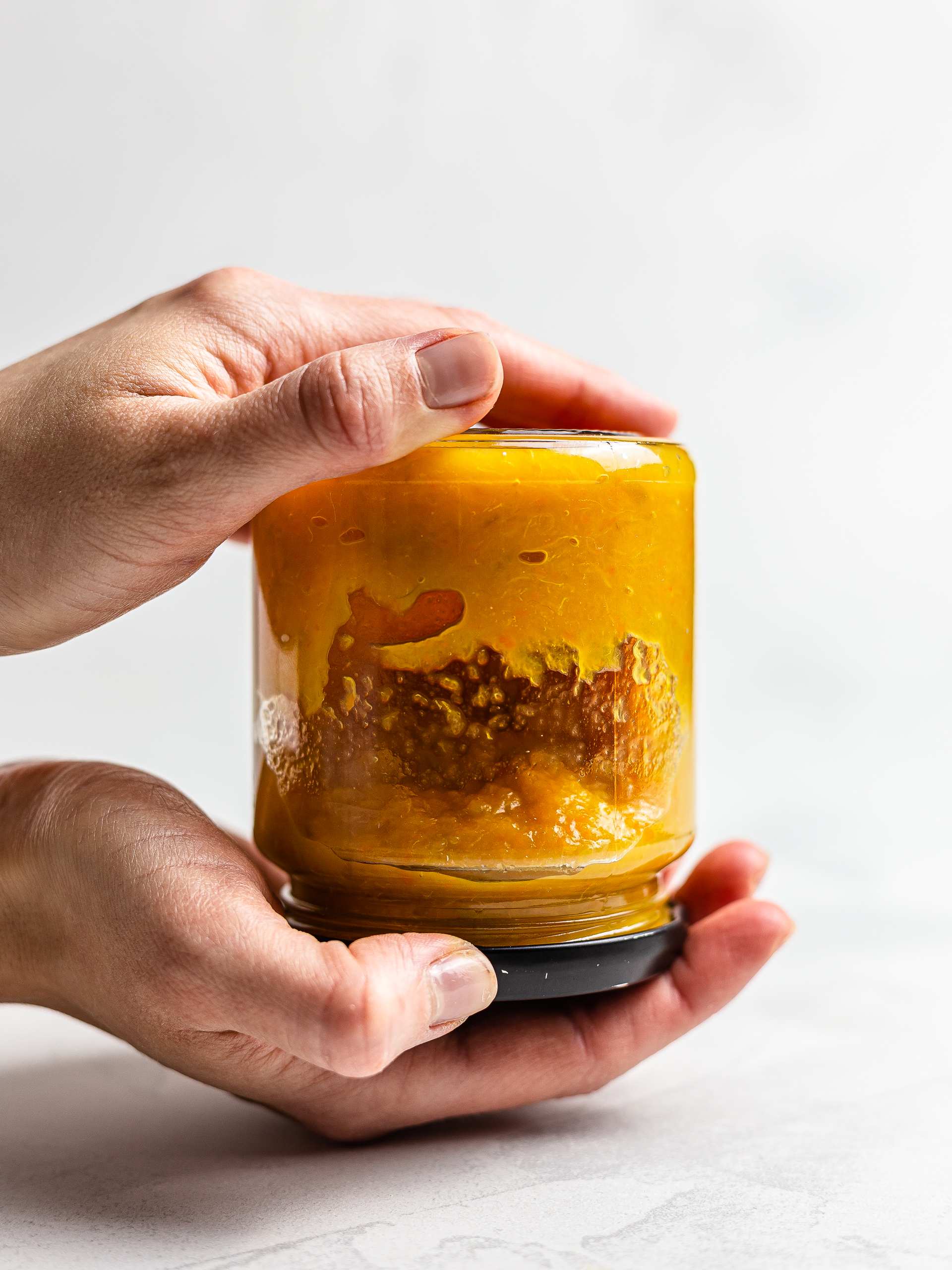
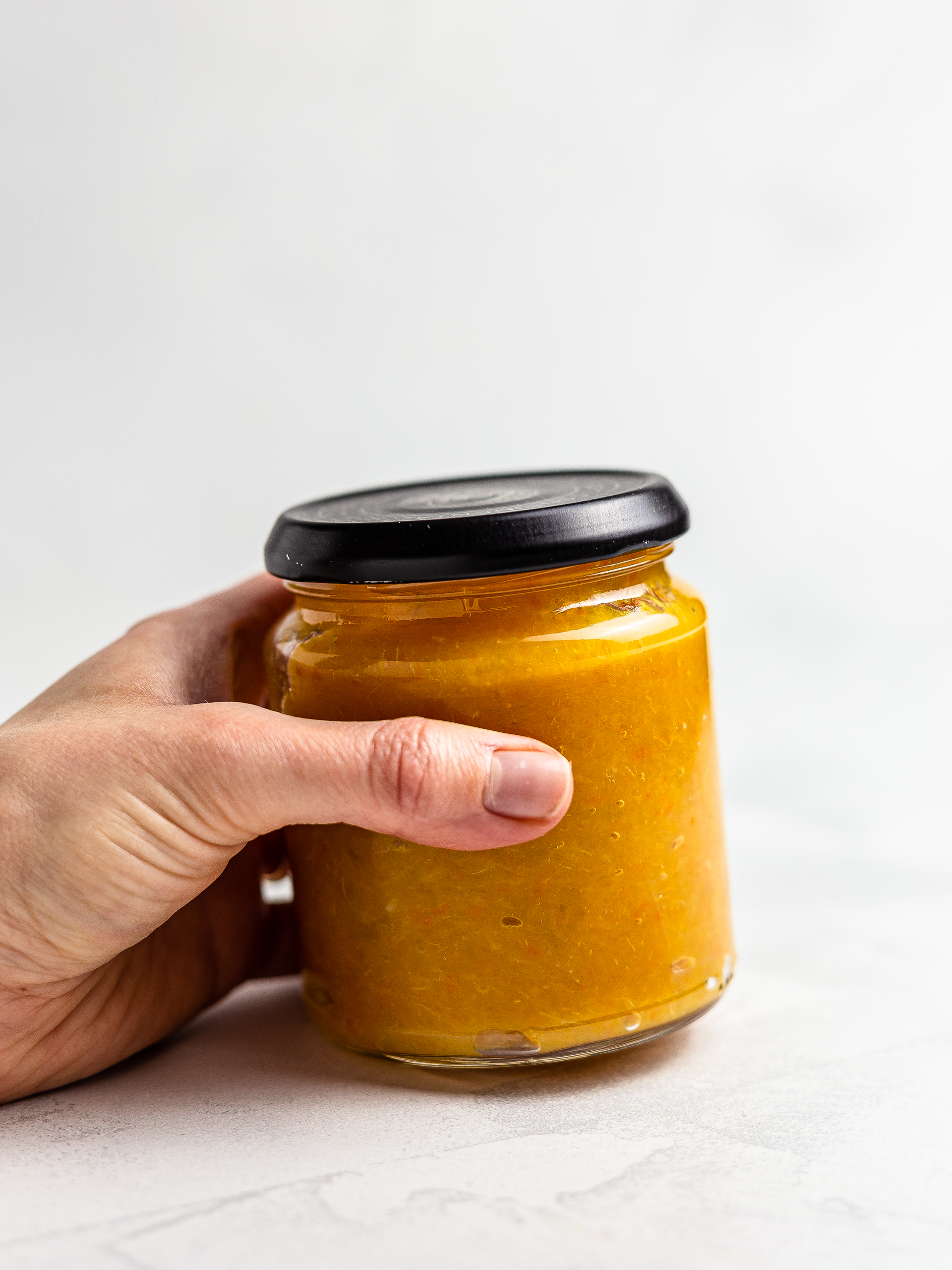
Tips
Store the sealed jam jars in a cupboard for up to 4 months. Once opened, keep the orange marmalade in the fridge for up to a week.
